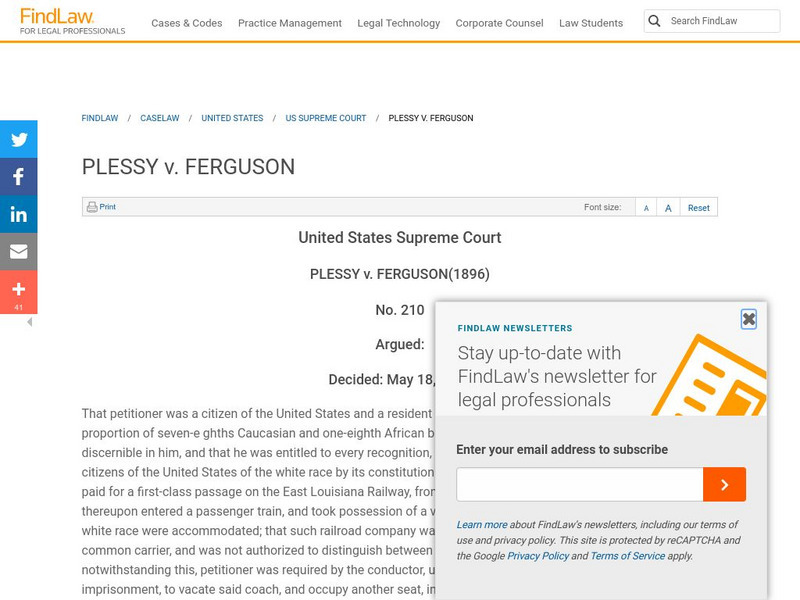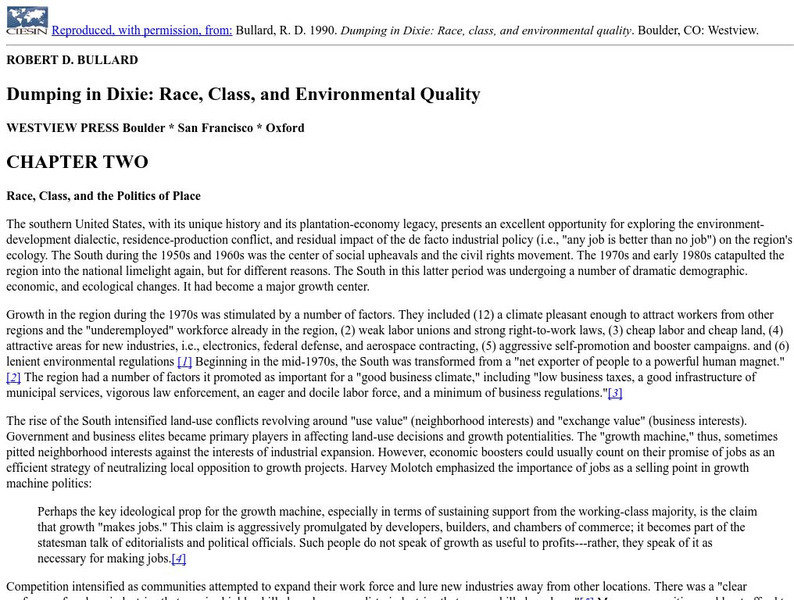Yale University
Yale New Haven Teachers Institute: Changing Attitudes in America
A collection of lesson plans that help teachers examine diversity, institutional racism, and other topics in social justice.
Gilder Lehrman Institute of American History
Gilder Lehrman Institute: History Now: Women and the Great Depression
[Free Registration/Login Required] A very interesting essay showing how the Great Depression affected women as housewives and as employees. See how many New Deal programs discriminated against women, and find out who supported women's...
Gilder Lehrman Institute of American History
Gilder Lehrman Institute: The Tragedy of Japanese Internment
[Free Registration/Login Required] A glimpse into an embarrassing time in American history when Japanese American citizens became enemies in their own country. How were they treated? Where were they sent? How were their lives impacted?...
Thomson Reuters
Find Law: u.s. Supreme Court: Plessy vs. Ferguson
Transcript of the infamous Supreme Court decision that established the constitutionality of the principle of "Separate but equal," public facilities for members of different races. This was eventually overturned by the 1954 and 1955...
Yale University
Yale New Haven Teachers Institute: Negro Holocaust: Lynching and Race Riots
A lesson plan unit with good background information for learners. Details the history of lynching and race riots in America and the treatment of African-Americans from 1880 to 1950.
Gilder Lehrman Institute of American History
Gilder Lehrman Institute: The Civil Rights Movement: Major Events and Legacies
[Free Registration/Login Required] An essay that speaks of the major events and legacies of the Civil Rights Movement.
Gilder Lehrman Institute of American History
Gilder Lehrman Institute: History Now: Securing the Right to Vote: Selma to Montgomery Story
[Free Registration/Login Required] Lesson plan asking this essential question: "What conditions created a need for a protest march from Selma to Montgomery in 1965 and what did that march achieve?"
PBS
Wnet: Thirteen: The Rise and Fall of Jim Crow: The Atlanta Compromise Speech (1895)
Find out how Booker T. Washington tried to allay the fears of white Southerners in his speech in Atlanta in September, 1895. Although hailed as a new era in which blacks would give up their civil and political rights and in return get...
Center for Innovation in Engineering and Science Education, Stevens Institute of Technology
Dumping in Dixie: Race, Class, and Environmental Quality
The "Race, Class, and the Politics of Place" chapter from a book with the above title. The chapter discribes the typical pattern of economic development that institutionally aludes blacks in the Southern Region of the US.
University of Virginia
U of Virginia: Bad Blood: The Tuskegee Syphilis Study
Participants in the Tuskegee Syphilis Study were never told that they had syphilis. Instead, the doctors and scientists said they had "bad blood." Find out what took place during this study, and the social and political consequences...
Smithsonian Institution
National Museum of American History: Students "Sit" for Civil Rights
Read the book, "Freedom on the Menu" about the Greensboro Sit-Ins and use the background information and follow up activities provided to enhance the story.
Smithsonian Institution
National Portrait Gallery: American Women: Marian Anderson
A brief, but powerful, biography of Marian Anderson, who broke racial barriers with her beautiful voice. See a portrait of her depicting her concert at the Lincoln Memorial.
US Department of Justice
U.s. Department of Justice: Omnibus Crime Control and Safe Streets Act of 1968
A complete government description of Section 3789d of the Omnibus Crime Control and Safe Streets Act of 1968, which explicitly prohibits the federal government from controlling state or local police agencies, and which explicitly...
Smithsonian Institution
National Portrait Gallery: American Women: Leontyne Price
Leontyne Price broke racial barriers with the power of her voice. See a portrait of her and read a brief account of her performances that changed the operatic world.











